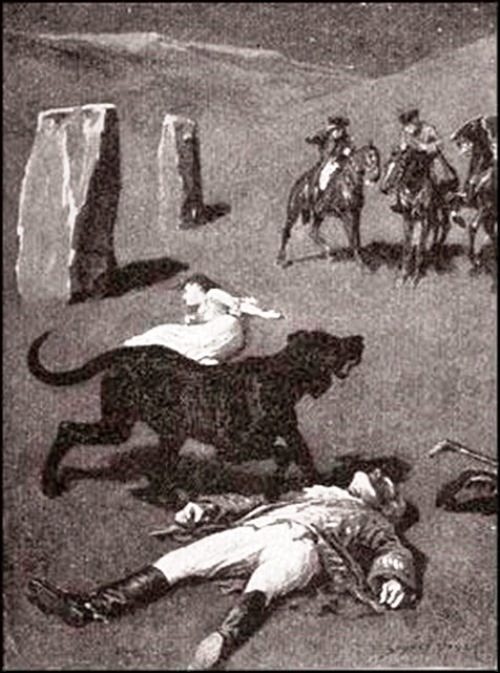Mysterious Black Dog
In fact, this dog a mythological figure in Irish, Scottish, and British folklore. Dogs are variously presented as friends to humans, supernatural entities, or even dark, menacing creatures. Great Britain is rife with tales of phantom black dogs. Nearly every county has at least one example of such a beast. This spectral creature, usually shaggy and as big as a calf, was familiar throughout the insular Celtic world as an indication of great change and probable death. Occasionally Black Dogs could be helpful, but it was necessary to be wary of them, for one glance of their eyes could kill.
In Westmoreland the dog was called the Capelthwaite and performed doggy services, like rounding up herds, for the locals, while the same creature on the Isle of Man was called the Mauthe Doog. The Black Dog is also familiar to Irish folklore and has been sighted at Irish sacred sites as recently as the 1990s. It is likely that lore about this ghostly creature inspired Sir Arthur Conan Doyle’s “The Hound of the Baskervilles.”
In northern England this beast was sometimes called a Barguest and thought to be a portent of death; the Barguest led all the dogs of a district on a rampage through an area where death was about to occur, all howling and creating a memorable disturbance. In East Anglia the dog is called Black Shuck, while in Cumbria it was Shriker.
There is also a popular dog story attached to the town of Beddgelert in Wales. In this tale, a man comes home to find his baby’s crib empty and blood on the mouth of the faithful family dog. Certain that the dog has murdered his baby, the man kills the dog. He finds out too late that the baby is safe under the crib and the blood was from a wolf the dog had killed. The town where this sad event is said to have occurred was named for the dog, Gelert.
In English folklore, supernatural black dogs are said to haunt the countryside. Nearly every county has at least one example. The two most familiar legendary black dogs are the Barghest of Yorkshire and Black Shuck of East Anglia. The name of the latter likely derives from the Old English scucca, which means “demon.” These beasts are nocturnal and are generally described as monstrous dogs with huge teeth and claws. Sometimes headless, they are portents of death or disaster.
Meanwhile, in the various counties of Britain, they have different names:
Cornwall: the Devil’s Dandy (or Dando) Dogs
Devon: the Yeth (Heath) or Wisht Hounds
Peel Castle on the Isle of Man: the Moddey Dhoo, or Mauthe Doog
Somerset: the Gurt Dog
Suffolk: Old Shock
West Yorkshire: Guytrashm, which in Lancashire is reduced to “Trash” or changed to “Skriker”
In 1127, Abbot Henry of Poitou was appointed to Peterborough Abbey. He recorded that “as soon as he came there… soon afterwards many people saw and heard many hunters hunting. The hunters were black and big and loathsome, and their hounds all black and wide-eyed and loathsome, and they rode on black horses and black goats.”
Medieval Welsh author Walter Map (c.1140–1209 C.E.) described a similar wild hunt around 1190. Map also wrote of the legend of Wild Edric in the Clun area of the Welsh marches. This legend, which persevered into the twentieth century, told of Edric, who was said to haunt the hills around Church Stretton in the form of a huge black dog.
Folklore also tells of some dramatic consequences that were the result of phantom black dog sightings. On Sunday, August 4, 1577, an extremely violent thunderstorm shook the church of Bungay, Suffolk, in England. A fearful black dog appeared inside the church. Two parishioners who were touched by the animal were instantly killed, and a third shriveled up like a drawn purse. On the same day, a similar hound appeared in the church at Blythburgh, seven miles away. This event resulted in the death of three people and the sudden illness of several others. Today, the Blythburgh market’s weather vane depicts the fiendish hound.
As recently as 1960, a supernatural black dog is said to have been seen by two people in Somerset. Both died soon afterward. East Anglia, Essex, and Buckinghamshire all have examples of phantom dogs that arrived suddenly and disappeared in dramatic flashes, with horrifying results. In one case, a farmer burned to death, along with his horse and wagon.
Black dogs are mentioned in a few isolated instances in Latin American tales. But the phantom black dog, native to the British Isles, remains a singularly British phenomenon.
Sources:
Article by Bob Trubshaw
Sherman Storytelling An Encyclopedia of Mythology and Folklore pdf
images: vk.com/public50291138









